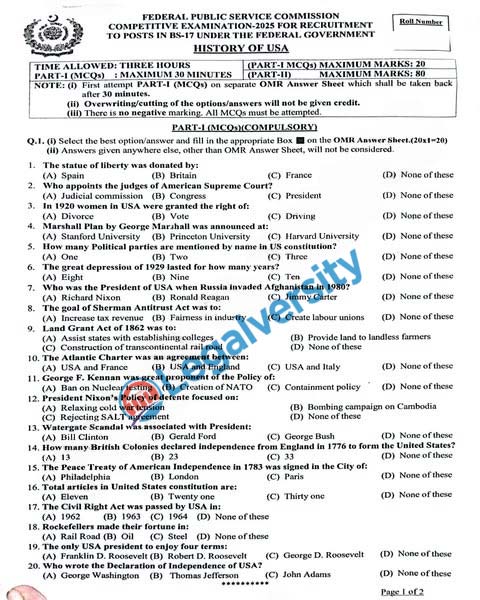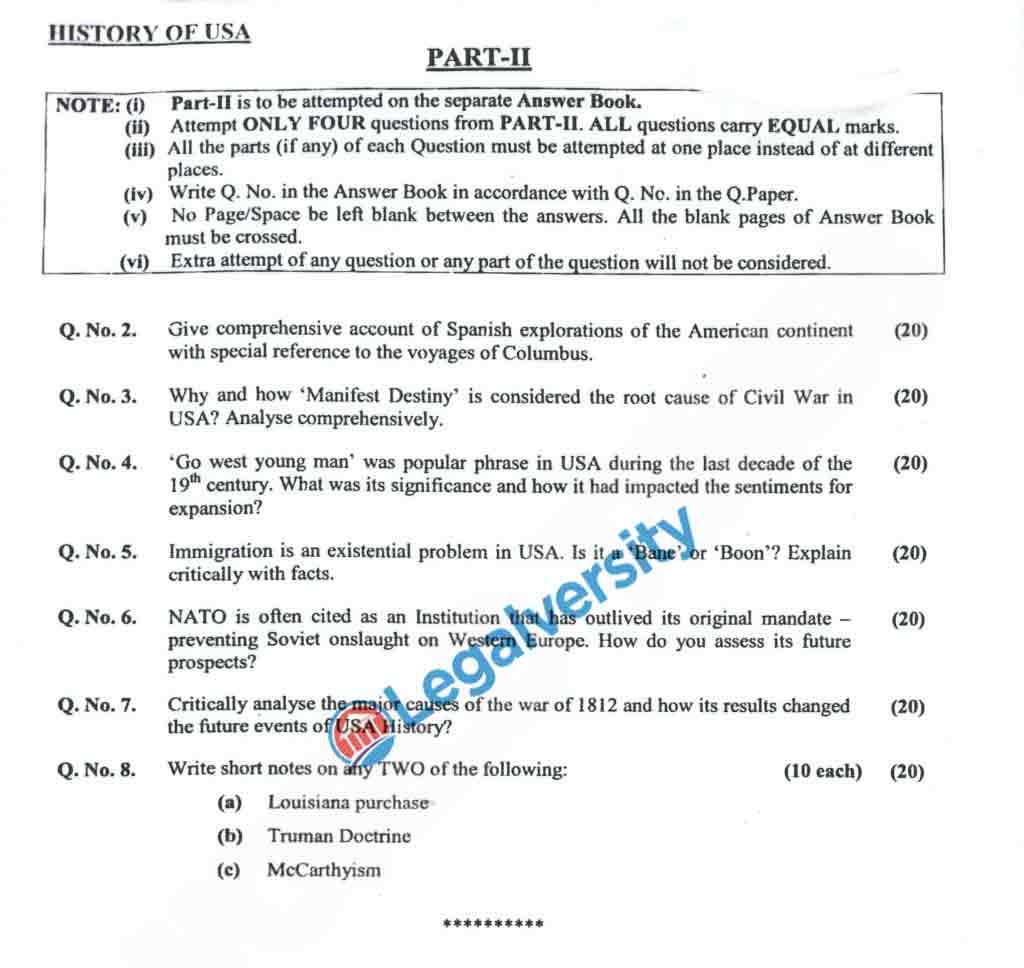The paper on History of the USA is optional in the CSS competitive examination 2025. Here, you will find the CSS History of USA past Paper 2025. I will also provide a summary of the paper, in which you will analyze what topics were given and how difficult they were. This lets you better understand the concept of paper and prepare well for future examinations.
CSS History of USA Past Paper 2025
Q1. Give a comprehensive account of Spanish explorations of the American continent with special reference to the voyages of Columbus.
Q2. Why and how Manifest Destiny is considered the root cause of the Civil War in the the USA? Analyse comprehensively.
Q3. “Go west young man” was a popular phrase in the USA during the last decade of the 19th century. what was its significance and how did it impact the sentiments for expansion?
Q4. Immigration is an existential problem in the USA. Is it a Bane or Boon? Explain critically with facts.
Q5. NATO is often cited as an institution that has outlived its original mandate preventing Soviet onslaught on Western Europe. How do you assess its future prospects?
Q6. Critically analyze the major causes of the War of 1812 and how its results changed the future events of the USA history.
Q7. Write short notes on any two of the following:
- Louisiana purchase
- Truman Doctrine
- McCarthyism
Critical Evaluation of the Paper
The Spanish conquest of the American continent was prompted by a pursuit of riches, religious spread, and territorial domination, essentially defining the New World. The most monumental of these ventures was commanded by Christopher Columbus, who, sponsored by King Ferdinand and Queen Isabella of Spain, set out in 1492 on a westward voyage to discover a direct passage to Asia.
Rather, he came to the Bahamas, where Spanish presence in the Americas began. Columbus’s return trips (1493, 1498, and 1502) consolidated Spanish claims, bringing Hispaniola, Cuba, and the coast of Central and South America under Spanish rule. Other explorers, such as Hernán Cortés, who defeated the Aztec Empire (1519–1521), and Francisco Pizarro, who overthrew the Inca Empire (1532–1533), solidified Spanish rule.
These ventures brought cultural exchanges, the diffusion of Christianity, and economic exploitation via the encomienda system, but also brought the destruction of native populations through warfare and diseases such as smallpox. The idea of Manifest Destiny, that the United States was destined to spread throughout North America, served to centralize an intensified sectional conflict, which eventually led to the Civil War (1861–1865).
This policy, immensely popular in the mid-19th century, legitimized territorial gains like Texas (1845), expansion of the Oregon Trail (1846), and the Mexican-American War (1846–1848). The Treaty of Guadalupe Hidalgo (1848) introduced immense regions, which again raised the debatable issue: Would slavery be allowed in these new states?” The Missouri Compromise (1820) and Compromise of 1850 tried to reconcile free and slave states, but tensions mounted with the Kansas-Nebraska Act (1854) and the Dred Scott decision (1857).
The speedy expansion spurred Southern pro-slavery ambitions and Northern abolitionist opposition so that the Civil War became inevitable as the country divided over the new territories’ future of slavery. The words “Go West, young man”, made famous by newspaper editor Horace Greeley in the 19th century, summarized the American expansionist spirit.
Spurring settlers to head west, this sentiment was driven by economic potential, land grants (through the Homestead Act of 1862), and the California Gold Rush (1848). The Transcontinental Railroad (1869) further facilitated movement, reinforcing the idea of American exceptionalism and self-containment. However, the westward movement came at a cost—violent conflicts with Native Americans, environmental degradation, and social displacement.
The sentiment of expansionism, embodied in this phrase, was a driving force behind American imperial ambitions in the Pacific and Latin America during the late 19th and early 20th centuries. Immigration in the USA has been a double-edged sword, presenting both challenges and benefits. On the other hand, immigration has long driven economic growth, supplying labor to sectors such as railroads, manufacturing, and technology.
Immigrants have played a crucial role in innovation, diversity, and entrepreneurship, with numerous current tech giants founded by first—or second-generation immigrants. Yet immigration also has drawbacks, including job competition, social integration problems, and concerns for national security. The Immigration Act of 1924 and current policies demonstrate efforts to manage the flow.
The issue remains unresolved: Is immigration required to maintain the U.S. economy, or does it burden national resources? The response hinges on economic requirements, political views, and social adaptation policies. NATO (North Atlantic Treaty Organization) was initially formed in 1949 as a mutual defense alliance against Soviet expansion in Europe during the Cold War. With the collapse of the USSR in 1991, others contend that NATO lost its initial mission, but it remains an active strategic alliance.
After the Cold War, NATO expanded eastward and took in former Warsaw Pact countries such as Poland, Hungary, and the Baltic republics, infuriating Russia. The Russia-Ukraine war (2022–ongoing) has rekindled NATO’s purpose, prompting Sweden and Finland to apply for membership. However, there are still challenges, including internal discord, the European Union’s autonomous defense aspirations, and the evolving U.S. foreign policy position. As uncertain as NATO’s future is, its evolution to counter cyber warfare, terrorism, and global security makes it more than an anti-Soviet alliance. The War of 1812 (1812–1815) between the United States and Britain had several causes, such as British interference in American trade, impressment of U.S. sailors, and aid to Native American resistance against U.S. expansion. The British naval blockade destroyed American commerce, and the war included battles like the burning of Washington, D.C. (1814) and the historic Battle of New Orleans (1815).
The war ended in a draw with the Treaty of Ghent (1814), but its impact was profound. It resulted in the decline of the Federalist Party, increased American nationalism, and an awareness that the U.S. required a more powerful military and economy. The war also undermined Native American resistance, setting the stage for additional westward expansion.
Short Notes
1. Louisiana Purchase (1803): A historic agreement in which the United States purchased 828,000 square miles from France for $15 million, roughly doubling U.S. size. Negotiated by President Thomas Jefferson, the acquisition gained control of the Mississippi River, solidified westward expansion, and paved the way for Manifest Destiny.
2. Truman Doctrine (1947): A Cold War doctrine launched by President Harry S. Truman, which preached containment of communism by offering military and economic support to nations resisting Soviet domination, e.g., Greece and Turkey. This doctrine saw the commencement of U.S. global interventionism during the Cold War.
3. McCarthyism (1950s): An era of anti-communist hysteria in America, spearheaded by Senator Joseph McCarthy, who accused people of being communist sympathizers without adequate proof. The House Un-American Activities Committee (HUAC) carried out investigations, resulting in blacklists, loss of jobs, and destroyed reputations. It represented Cold War paranoia and the perils of political extremism.
Each of these turning points significantly influenced American identity, policies, and foreign relations, with a lasting impact on the history of the United States.
View the CSS History of USA past paper 2025


You can also read the CSS Notes and view all previous papers on CSS
